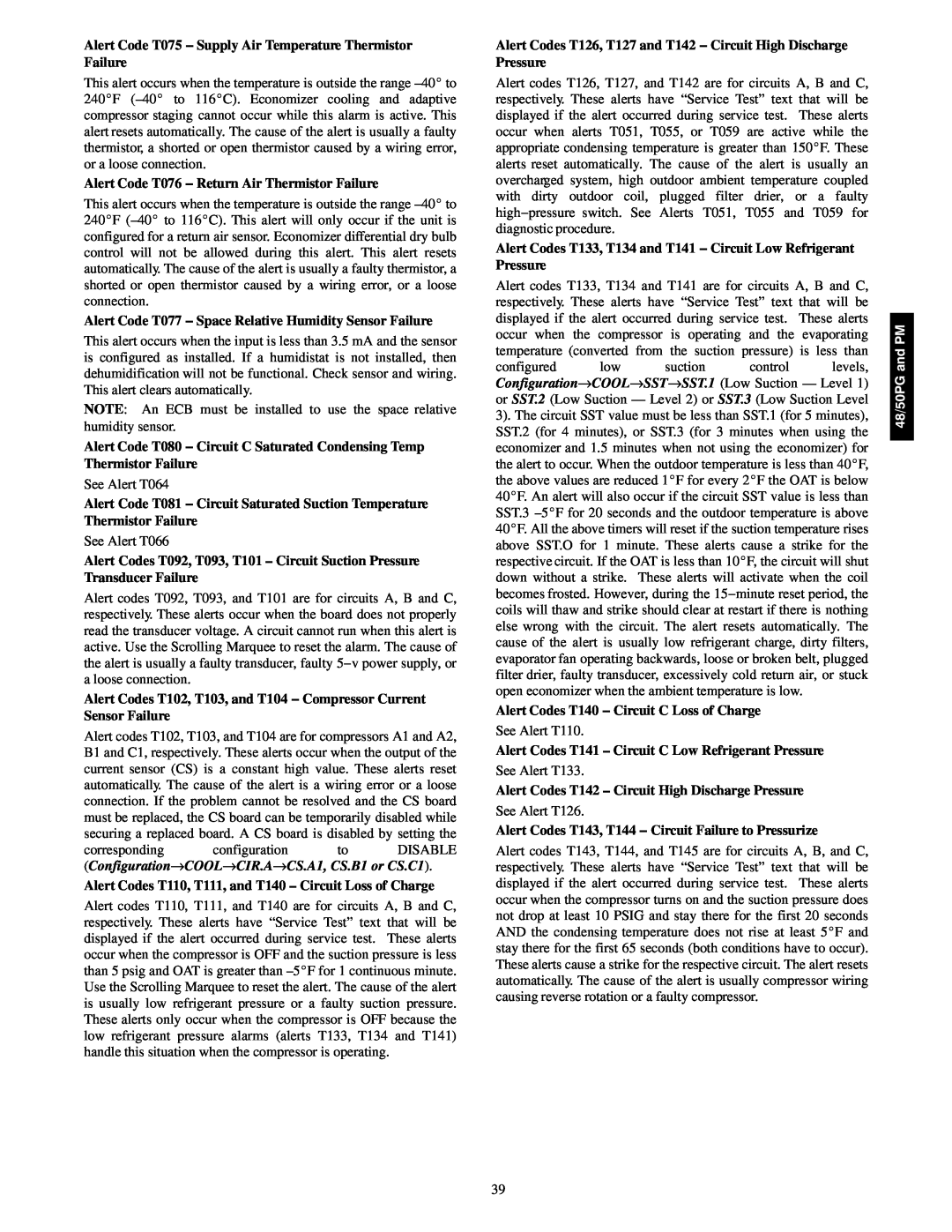Alert Code T075 − Supply Air Temperature Thermistor Failure
This alert occurs when the temperature is outside the range
Alert Code T076 − Return Air Thermistor Failure
This alert occurs when the temperature is outside the range
Alert Code T077 − Space Relative Humidity Sensor Failure
This alert occurs when the input is less than 3.5 mA and the sensor is configured as installed. If a humidistat is not installed, then dehumidification will not be functional. Check sensor and wiring. This alert clears automatically.
NOTE: An ECB must be installed to use the space relative humidity sensor.
Alert Code T080 − Circuit C Saturated Condensing Temp Thermistor Failure
See Alert T064
Alert Code T081 − Circuit Saturated Suction Temperature Thermistor Failure
See Alert T066
Alert Codes T092, T093, T101 – Circuit Suction Pressure Transducer Failure
Alert codes T092, T093, and T101 are for circuits A, B and C, respectively. These alerts occur when the board does not properly read the transducer voltage. A circuit cannot run when this alert is active. Use the Scrolling Marquee to reset the alarm. The cause of the alert is usually a faulty transducer, faulty 5−v power supply, or a loose connection.
Alert Codes T102, T103, and T104 − Compressor Current Sensor Failure
Alert codes T102, T103, and T104 are for compressors A1 and A2, B1 and C1, respectively. These alerts occur when the output of the current sensor (CS) is a constant high value. These alerts reset automatically. The cause of the alert is a wiring error or a loose connection. If the problem cannot be resolved and the CS board must be replaced, the CS board can be temporarily disabled while securing a replaced board. A CS board is disabled by setting the
corresponding configuration to DISABLE (Configuration→COOL→CIR.A→CS.A1, CS.B1 or CS.C1).
Alert Codes T110, T111, and T140 – Circuit Loss of Charge
Alert codes T110, T111, and T140 are for circuits A, B and C, respectively. These alerts have “Service Test” text that will be displayed if the alert occurred during service test. These alerts occur when the compressor is OFF and the suction pressure is less than 5 psig and OAT is greater than
Alert Codes T126, T127 and T142 − Circuit High Discharge Pressure
Alert codes T126, T127, and T142 are for circuits A, B and C, respectively. These alerts have “Service Test” text that will be displayed if the alert occurred during service test. These alerts occur when alerts T051, T055, or T059 are active while the appropriate condensing temperature is greater than 150_F. These alerts reset automatically. The cause of the alert is usually an overcharged system, high outdoor ambient temperature coupled with dirty outdoor coil, plugged filter drier, or a faulty high−pressure switch. See Alerts T051, T055 and T059 for diagnostic procedure.
Alert Codes T133, T134 and T141 − Circuit Low Refrigerant Pressure
Alert codes T133, T134 and T141 are for circuits A, B and C, respectively. These alerts have “Service Test” text that will be displayed if the alert occurred during service test. These alerts occur when the compressor is operating and the evaporating temperature (converted from the suction pressure) is less than
configured low suction control levels, Configuration→COOL→SST→SST.1 (Low Suction — Level 1) or SST.2 (Low Suction — Level 2) or SST.3 (Low Suction Level 3). The circuit SST value must be less than SST.1 (for 5 minutes), SST.2 (for 4 minutes), or SST.3 (for 3 minutes when using the economizer and 1.5 minutes when not using the economizer) for the alert to occur. When the outdoor temperature is less than 40_F, the above values are reduced 1_F for every 2_F the OAT is below 40_F. An alert will also occur if the circuit SST value is less than SST.3
Alert Codes T140 − Circuit C Loss of Charge
See Alert T110.
Alert Codes T141 – Circuit C Low Refrigerant Pressure
See Alert T133.
Alert Codes T142 – Circuit High Discharge Pressure
See Alert T126.
Alert Codes T143, T144 − Circuit Failure to Pressurize
Alert codes T143, T144, and T145 are for circuits A, B, and C, respectively. These alerts have “Service Test” text that will be displayed if the alert occurred during service test. These alerts occur when the compressor turns on and the suction pressure does not drop at least 10 PSIG and stay there for the first 20 seconds AND the condensing temperature does not rise at least 5_F and stay there for the first 65 seconds (both conditions have to occur). These alerts cause a strike for the respective circuit. The alert resets automatically. The cause of the alert is usually compressor wiring causing reverse rotation or a faulty compressor.
48/50PG and PM
39
